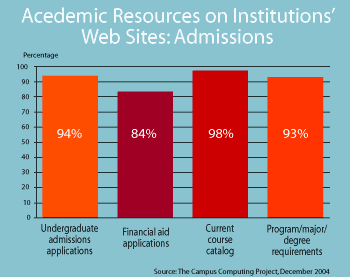STATS: Online Student Services Come of Age
From the Syllabus2005 Executive Summit Survey: Institutions leverage online
student services to foster community and value the customer.
ONE OF THE MAJOR THEMES explored this past summer at the Syllabus2005
Executive Summit (www.campus-
technology.com/summer2005) was “Students as Customers: Online Student Services.”
The report compiled for Executive Summit participants by Eduventures Inc. (www.eduventures.com)
includes the results of a survey of available research, along with selected
expert and participant commentary. The following is derived from that report.
Key Drivers of Online Student Services
Driving institutional interest in providing new
services is the increasing sensitivity to student expectations of a lifestyle
comparable to the ones they are familiar with as digital consumers. Simply put,
students’ experiences with the likes of Amazon.com and iTunes have conditioned
them to expect the same level of service from their institutions.
Strategic institutional goals. While online student services take many
forms and provide access to several types of services (e.g., registration, eCommerce,
and financial aid), student retention and student services are identified as
two of the truly high-impact areas for technology inside post-secondary institutions.
Those areas are undergoing fundamental changes as their operations and systems
shift from traditional, paper-based ones, to 24/7/365 availability. This shift
is often tightly linked to an institution’s strategic academic and economic
objectives; the goals are to provide value to students while also providing
institutions with the means to better shape admissions-yield demographics and
realize staff-productivity gains.
CRM and relationship management. A cornerstone of many institutions’
new approaches to customer service: maximizing the use of the latest customer/constituent
relationship management (CRM) technologies. Similar to CRM practices in the
commercial and corporate world, the move to online student CRM addresses the
economics that drive institutions, by quickly leveraging the student relationship
into an institutional commitment.
Student-Centered Recruitment/Admissions: Data Points
Enrollment management/recruitment systems represent the vanguard of a shift
toward relationship-based systems. “Increasing enrollment” ranked within the
top 10 institutional strategic objectives in a 2004 Eduventures survey, Higher
Education Survey on Leadership, Innovation, and Technology, with 64 percent
of senior administrators citing technology as contributing to the attainment
of these objectives. From a student lifecycle point of view, technology is increasingly
being used to facilitate relationship management. Web sites are a first point
of contact for many prospective students, as institutions move from using the
Internet as a supplemental means of offering institutional information, to the
primary mode. A March 2005 survey of 661 higher ed institutions by the National
Association for College Admission Counseling (NACAC State of College Admission;
www.nacac.com) found that
36 percent of students inquiring about application to the colleges and universities
surveyed use the Web or e-mail.
Applications only, or end-to-end? The admissions process is conducted
online to varying degrees across institutions, while the general trend is toward
end-to-end online capability. The December 2004 Campus Computing Project (below)
shows high numbers of admissions-related resources offered on college and university
Web sites. While there is little doubt that providing online access to admissions
and other services provides compelling value for institutions in terms of staff
productivity and competing for new students, students’ technology expectations
are paramount when it comes to delivering student services.
